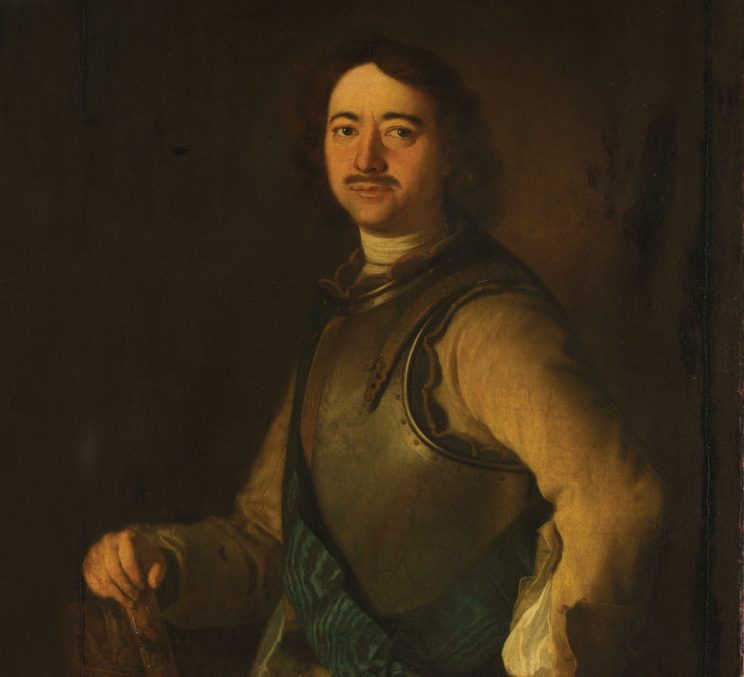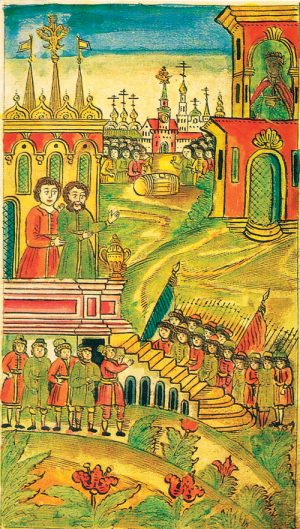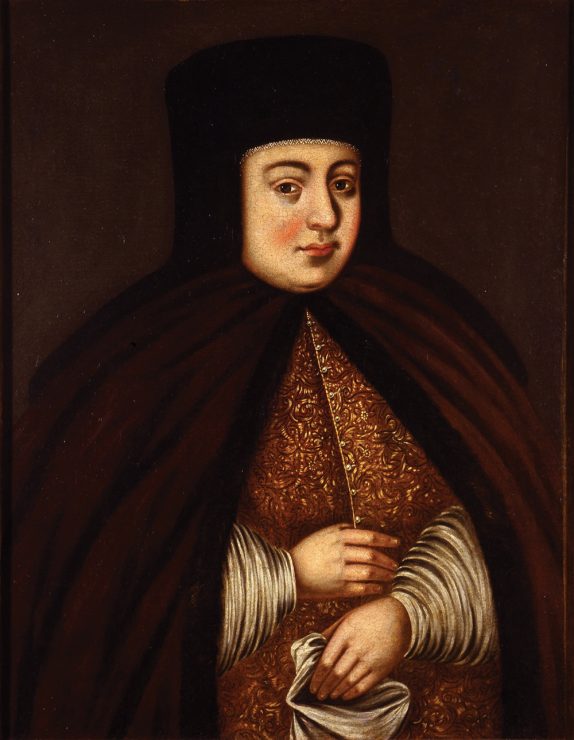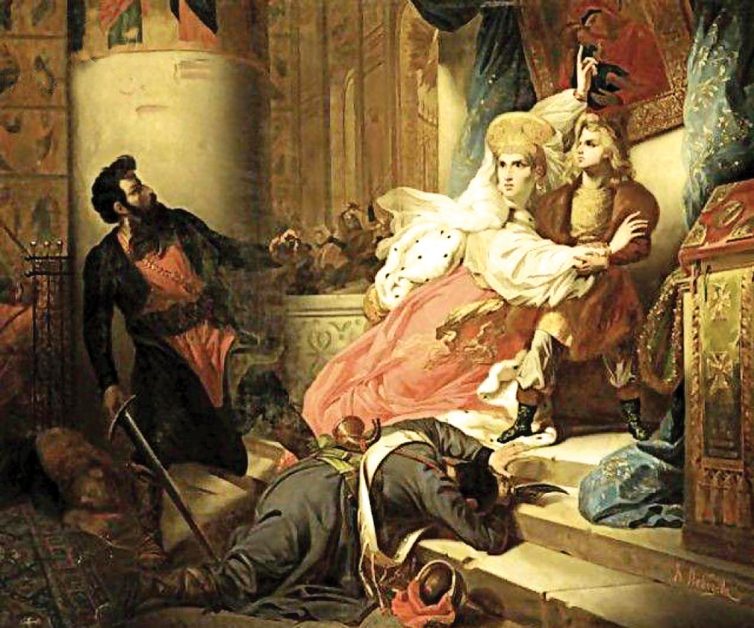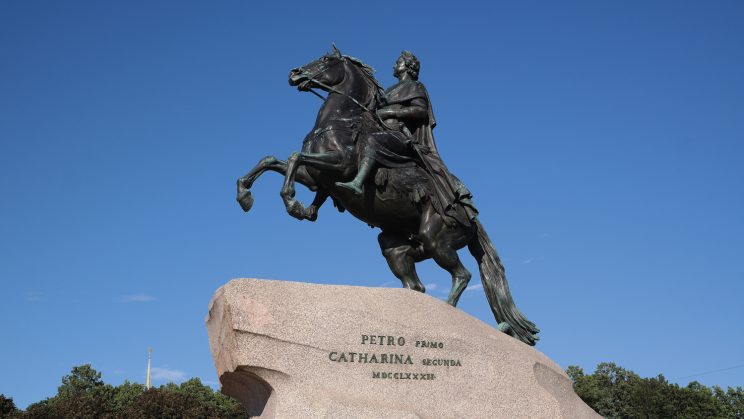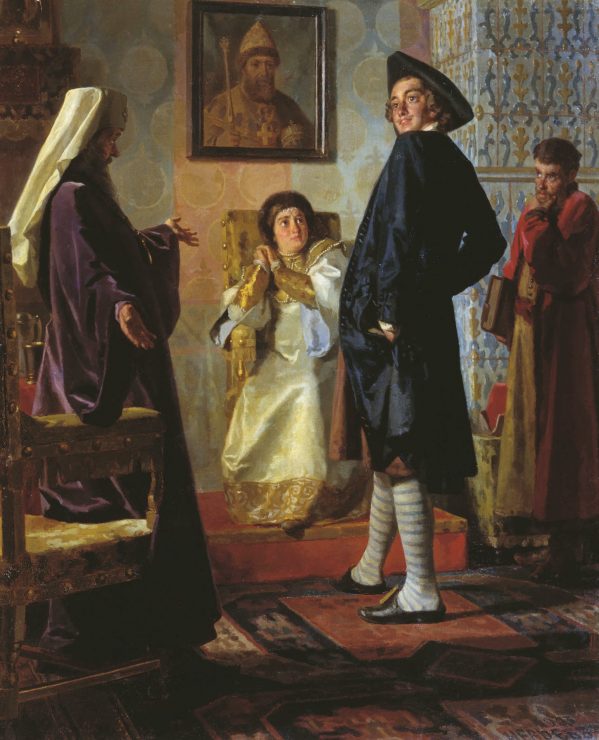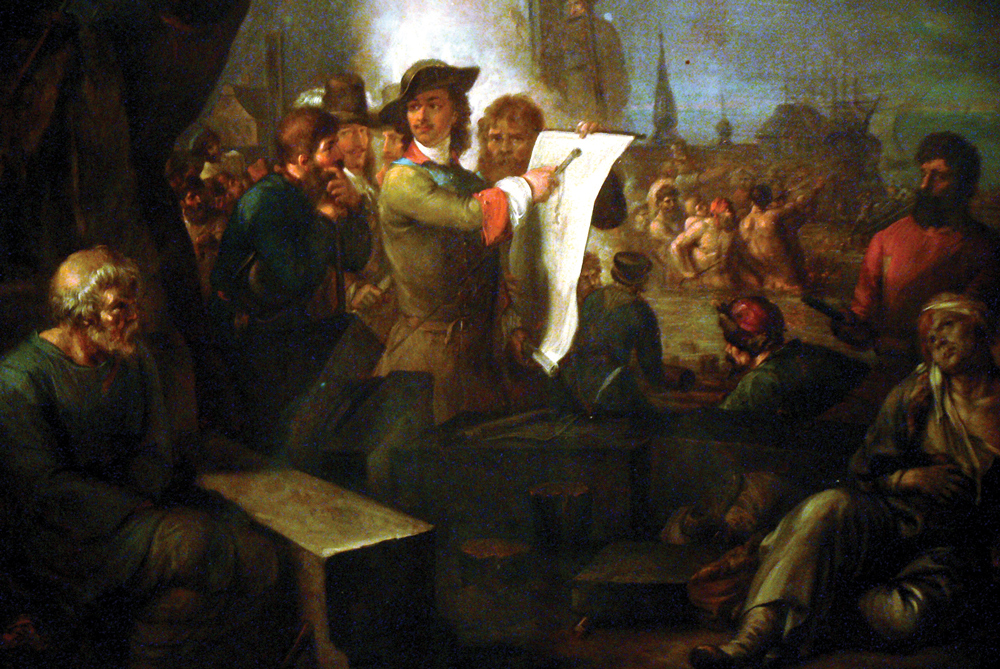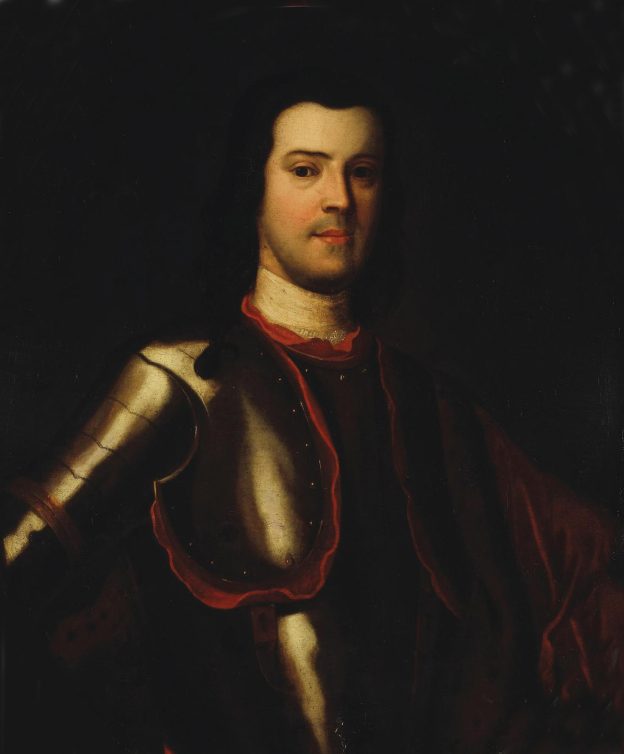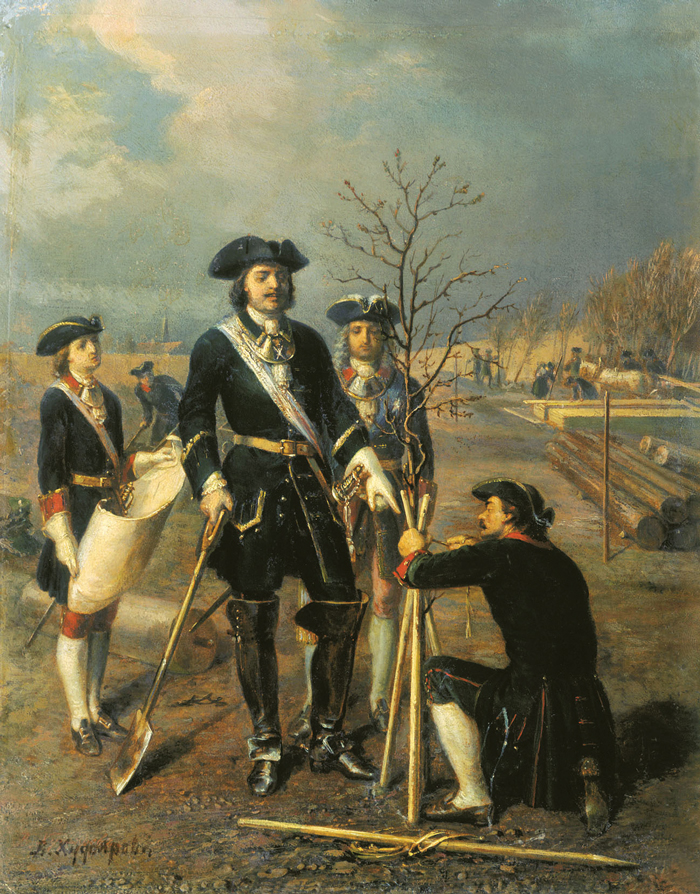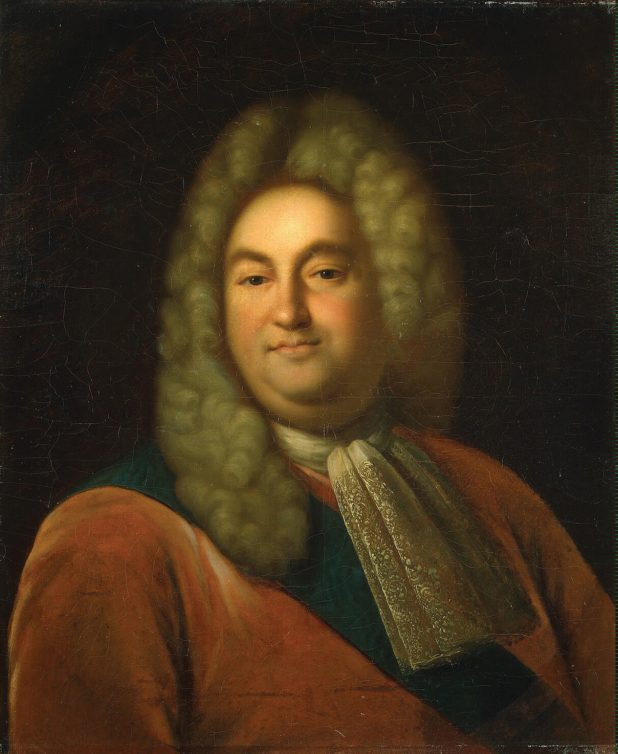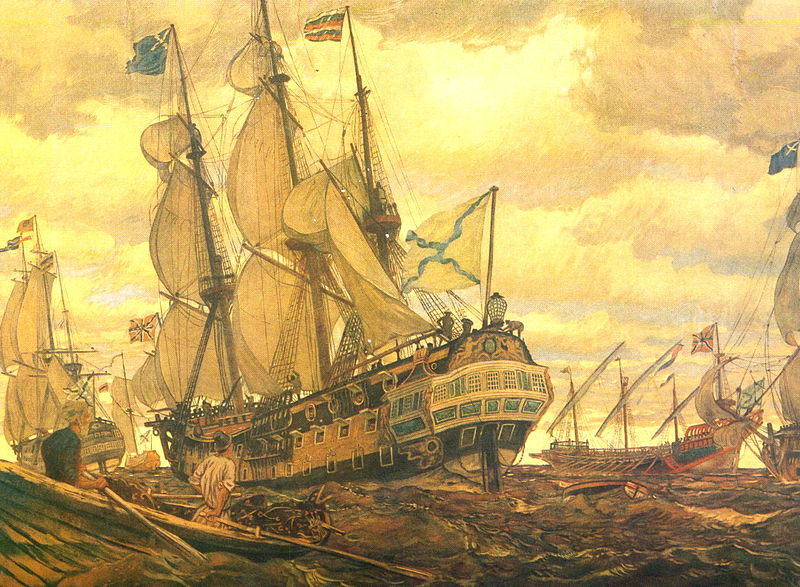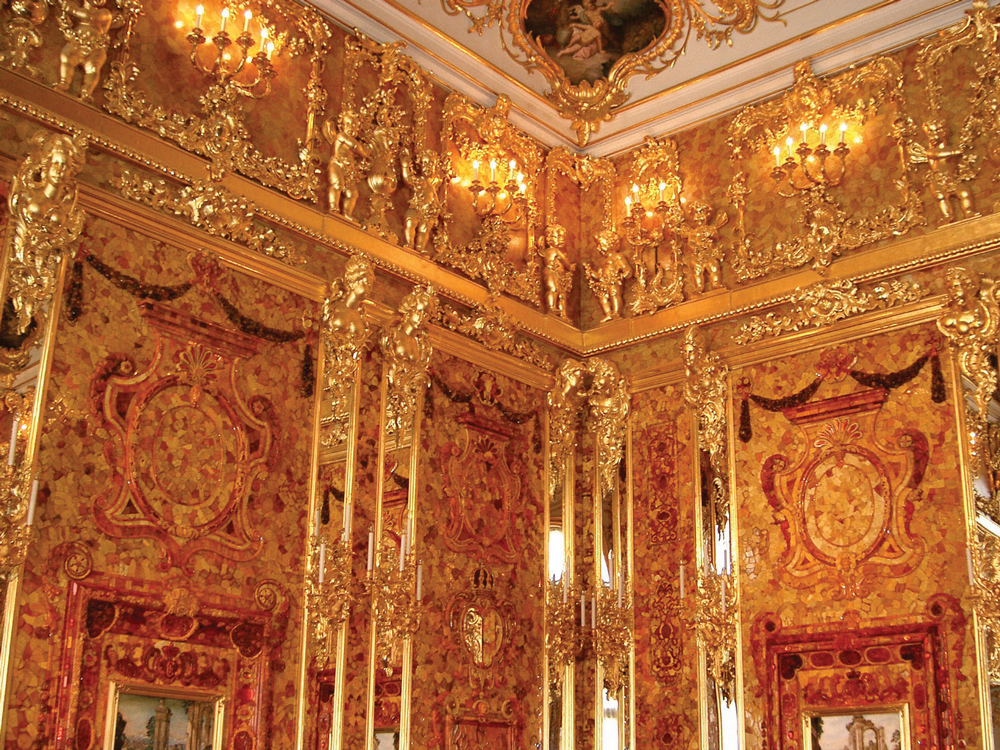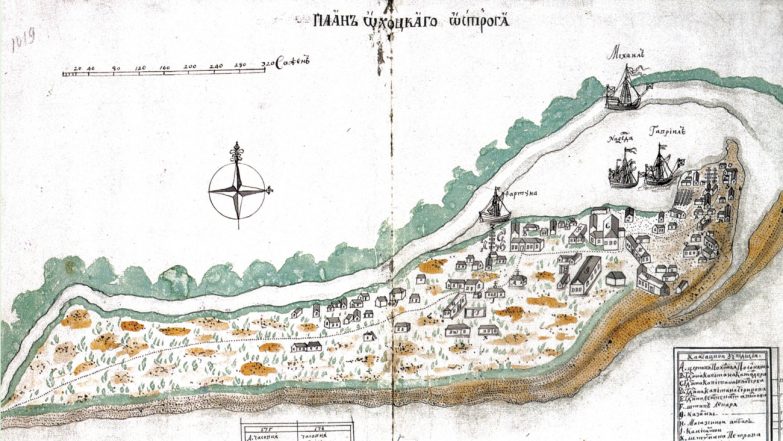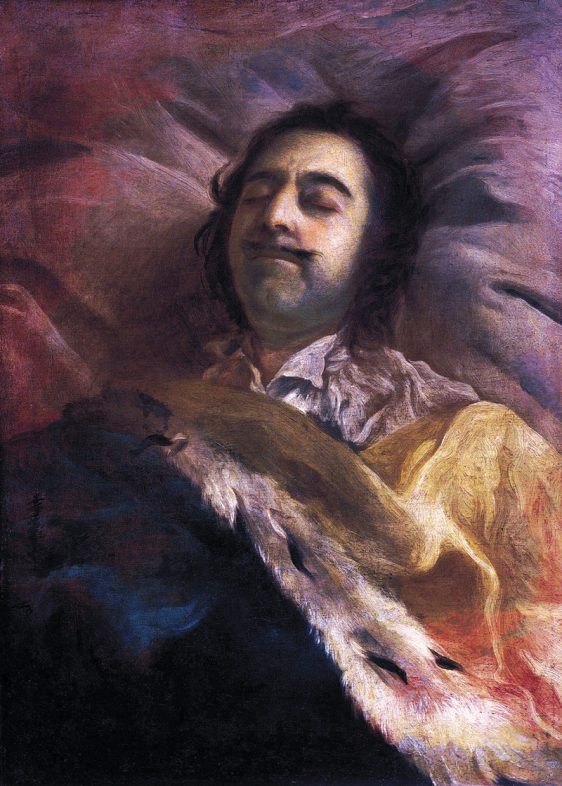The Czar of Progress
Peter I, also known as Peter the Great (1672–1725), is a controversial figure in Russian history. His admirers are as many and varied as his detractors, and his life and works are filled with contradictions, both positive and negative. He spearheaded Russia’s meteoric rise from primitive backwater to European power, but his methods were brutal, and he was a merciless opponent.
Peter’s whole career was full of strife. He began his reign in 1682, when he was barely a man, and his army’s elite musketeers (or streltsy) promptly rebelled against him. Many of his friends and relatives were killed in the aftermath, and Peter’s beloved mentor, his mother’s guardian Artamon Matveyev, was cut down before his eyes.
As the father of modern Russia, Peter the Great has inspired dozens of oil portraits, some by great artists, others anonymous. Many of these works, including this 18th-century likeness, show the builder of St. Petersburg holding tools or architectural sketches
Later in the young czar’s career, his authority was challenged by his own son, Prince Alexis, who was promoted by a reactionary faction to overturn his father’s reforms. In the autumn of 1721, Peter labored to rebuild the capital of his dreams, St. Petersburg, after severe flooding. And in 1724, while inspecting iron-works in Finland, he plunged into icy waters to save drowning sailors, catching a chill that eventually claimed his life.
Jewish Roots
Peter’s father, Romanov czar Alexis Mikhailovich, married twice. Both his wives bore him children, giving rise to a bitter and bloody succession struggle after his death. The eldest son, Fyodr, died after less than five years in power, and the two remaining sons, Ivan and Peter, were both appointed in his place, with Sophia – their sister and half-sister, respectively – as regent. Peter’s mother, Natalya Naryshkina, was Alexis’ second wife. Highly intelligent, Natalya was rare among Russian women for her European education. She also had a Karaite ancestor – one Naryshko of the Crimean Peninsula – about whom she was quite open.
Czarina Natalya Naryshkina, Peter’s mother, was descended from a Crimean Karaite. Arriving in the Crimean Peninsula in the 12th century at the latest, the Karaite community flourished there until the Renaissance, despite rejection by Jews and Christians alike. Most eastern European Karaites were wiped out in the Holocaust, though they professed to be ethnically distinct from Jews. Natalya Naryshnika, oil on canvas, late 17th century
Interestingly enough, all Romanov rulers after Peter remembered their descent from this gentleman, exercising tolerance toward the Karaite minority in both Crimea and Lithuania. Peter himself ignored his roots; the Karaite connection doesn’t seem to have affected his attitude toward Jews.
Peter’s critics, however, never missed an opportunity to dredge up his Jewish origins and denounce him as the Antichrist himself. The Russian Orthodox Church particularly resented what it perceived as his modernizing crusade against religion and morality.
Extremely attached to his mother, Peter consulted her as his closest adviser in the first years of his reign. As regent for the two young czars, his half-sister Sophia had attempted to banish Natalya, forcing her to cede any authority she might have had and ordering many of the queen mother’s relatives killed. (Sophia tried to assassinate Peter too, during the musketeers’ revolt, which she masterminded.)
Peter’s mother rescues him from assassination during the Streltsy uprising of 1682
Once his rule was established, Peter made Leib Naryshkin, Natalya’s brother, his foreign minister and acting prime minister, while Natalya served as regent. Peter’s reign commenced in earnest only after his mother’s death in 1694. His feeble-minded half-brother Ivan, who was to rule jointly with him, died in 1696, leaving Peter the sole, undisputed czar.
The Great Expedition
Reaching adulthood, Peter cut an impressive figure, standing over two meters tall. As he began to govern in his own right, he sought to create a vision for Russia by studying other European countries. Thus his “Great Expedition” to western Europe set out in March 1697 with 250 men, ostensibly to recruit allies for Russia’s war against the Ottoman Empire, but unofficially to learn from the more developed European nations.
Peter himself joined the mission incognito, perhaps because, as an acclaimed sovereign and honored guest, he’d never see the true face of these countries, meeting ordinary people and understanding their circumstances. Despite his efforts to conceal his identity, rumors began to fly, though within the expedition itself the pretense continued.
Disguised as a commoner, Peter visits his mother before setting out on his great European expedition. This oil painting by Nikolai Nevrev from 1903 is actually inaccurate, as Czarina Natalya died in 1694, three years before the mission
After visiting Holland and Great Britain, the delegation headed home, apparently empty-handed. But by now the young ruler had become acquainted with a slew of professionals – including scientists seeking funding for a variety of ambitious projects – as well as energetic young soldiers impatiently awaiting promotion.
Back in Russia, Peter immediately put his experience to good use, determined to replicate Europe’s cultural, technological, and socioeconomic achievements. To kick off his reforms, he needed like-minded men, few of whom were to be found within his dominion. So he turned instead to those he’d come across on his European tour.
Personal Assistant
In early October 1697, António de Vieira, a minor Dutch naval officer whom Peter had met in Holland, received a registered letter from Russia. The letter invited him to serve as personal assistant to the czar – and become a Russian citizen, “Anton Devier.” The young man accepted without hesitation, launching the Russian career of one of the most famous Jews in Peter the Great’s court.
Little is known about de Vieira’s early life. He was born in the 1680s, after his family fled to Holland to escape the Portuguese Inquisition. His father, Manuel de Vieira, sold arms. António was twelve when his father died, after which the young man joined the Dutch navy. That might have been the end of the story had he not met Peter.
At first, Devier did function as Peter’s personal aide, but he was quickly promoted to naval secretary and, by age twenty-six, adjutant general. His swift rise aroused much envy, especially on the part of Duke Alexander Menshikov, a childhood friend of Peter’s with undisguised contempt for Jews. To complicate matters, Devier fell in love with the duke’s elder sister, who became pregnant with his child. When he asked for her hand, Menshikov’s servants threw him down the stairs. Undaunted, Devier complained to his short-tempered patron, who insisted that the duke allow the marriage.
In 1718, Peter founded St. Petersburg’s first police force. Devier, by now an aristocrat, headed the force with such devotion that the city was soon noticeably cleaner and less corrupt. Price hikes exceeding 10 percent without justification were punishable with both heavy fines and banishment to Siberia. Polluting the River Neva meant a whipping as well as a fine. Devier also beautified the city with parks, lighting, and benches.
After Peter’s death in 1725, Anton Devier became the victim of a conspiracy cooked up by Duke Menshikov in revenge for his earlier humiliation. Devier was stripped of his rank and titles and condemned to hang. At the last minute, he was exiled to Siberia instead, where he became director of the port of Okhotsk and organized Russian naval expeditions around the continent.
In 1741, after Peter’s daughter Elizabeth was crowned empress, she brought Devier back from exile and restored all his credentials. He died in 1745 and received a royal burial.
Diplomat and Interpreter
Baron Peter Pavlovich Shafirov was another Jew who rose to prominence in the court of Peter the Great. Born in 1669, Shafirov was a talented diplomat and one of the most influential men in Russia, heading the postal service, two government ministries (mining and metallurgy, and international commerce), and the Russian delegation negotiating with the Ottoman Empire.
Shafirov’s father, Pavel, was a Polish Jew and adviser to a Russian aristocrat. Educated and blessed with a gift for languages, he was baptized together with the rest of his family and worked as a translator for the Russian Foreign Ministry.
Legend has it that Pavel Shafirov finagled a meeting between his eldest son and the czar whose name he shared. During this brief encounter, in the fabric store where the younger Shafirov worked, Peter the Great learned that the young man was fluent in German, Polish, and French as well as an excellent salesman. Whether or not there’s any truth to the tale, in 1697 Peter Shafirov found himself accompanying the czar’s Great Expedition as an interpreter.
Never aspiring to play the role of confidant, Shafirov kept a respectful distance from the monarch but proved himself indispensable. In Holland, for instance, he acquired materials for the soon-to-be-established Russian fleet.
Shafirov later joined Russia’s senior diplomatic corps, directing negotiations with the Polish-Lithuanian Union in an attempt to win allies for Russia’s war with Sweden (designed to give Russia an outlet on the Baltic Sea). He was promoted to secretary and assistant to the Russian foreign minister, effectively giving him control of Russian foreign policy and making him the most senior Russian diplomat in all but name.
In many ways, Peter Shafirov was not dissimilar to Peter the Great. Both were impatient, impulsive, and sometimes coarse. Shafirov was also a drunkard, though he claimed he used alcohol purely for professional purposes: the ambassadors who sat around his table drank profusely and spoke freely, leaking valuable information. In 1709 Shafirov was made chief minister – one of the highest government posts in Russia – and granted a feudal estate (complete with serfs) as well as the title of baron and a substantial monetary gift, all in recognition of his devoted service.
In 1711, the Russian army suffered a crushing defeat by the Ottomans near the Caspian Sea. Allied with Sweden, the Russians’ bitterest foe, the Ottomans pushed their enemies all the way back to the borders that had confined Russia two centuries earlier. The situation was so dire that Peter the Great was prepared to return all conquered territories to the Turks, hand over the area around St. Petersburg to the Swedes, and accept their own Stanisław Leszczyński as ruler of the Polish-Lithuanian Union. Thanks to Shafirov’s negotiations, however, Russia ultimately made minimal concessions to the Ottomans, keeping all the lands it had wrested from Sweden.
Swedish, British, and French diplomats claimed that without the enormous bribes Shafirov paid to various Ottoman functionaries, Turkey and Russia would never have signed a peace treaty. Even the sultan’s mother mysteriously became a fervent advocate of the accord.
Extremely wealthy, Peter Shafirov nonetheless used his position to increase his riches. Was Peter the Great aware that his advisers were robbing him – and everyone else – blind? Probably, but their unswerving support was essential in stabilizing his rule.
Shafirov’s downfall came about when Duke Menshikov accused the chief minister of corruption, nepotism, and disloyalty. In the resultant stormy trial of 1723, distant Jewish relatives of Shafirov were implicated as recipients of undeserved economic benefits.
Duke Alexander Menshikov, son of a Lithuanian nobleman who’d fallen on hard times, supported himself as a youngster by selling piroshky (pasties) on the streets of Moscow. At age fourteen, thanks to his talents and intelligence, Menshikov secured the post of Peter the Great’s personal attendant and quickly became his confidant and closest friend. It was Menshikov who made Catherine I empress of Russia after Peter’s death in 1725, entrenching himself as the power behind the throne. After Catherine’s two-year reign, his many enemies made sure he was charged with corruption and died in Siberian exile
Shafirov was convicted and consigned to the gallows, but he too was spared at the last minute (though all his possessions were confiscated, and his titles were revoked). Sent into Siberian exile, he never arrived. After a sudden deterioration in his health, he was permitted to remain in Novogrod, not far from Moscow.
Following Peter the Great’s death in 1725, Shafirov too was brought back to St. Petersburg and reinstated in his previous positions. All his property was returned to him, with the exception of his sword, which had been lost. Instead, he was given the saber of his patron, Peter the Great.
Shafirov died in 1739, and he too was buried with all due pomp and circumstance.
Court Jester
During Peter’s reign, the traditional court jester still figured significantly in royal circles. No mere entertainer wiling away the elites’ empty hours, the clown could tell his monarch truths that no one else dared reveal.
Sometimes performing in groups, clowns commonly amused the ruling family and their guests, providing a welcome distraction from affairs of state. Jesters in the court of Peter the Great’s niece, Czarina Anna Ivanovna, who recalled entertainer Ian Lacosta from Siberian exile.
One such royal comedian in the court of Peter the Great was Ian Lacosta. Born in Salé, Morocco, a city then ruled by Barbary pirates, Lacosta probably descended from conversos fleeing Portugal. He’d spent time in many European cities, constantly on the move. When his Hamburg real estate and insurance firm floundered, he thought he might fare better in Peter’s court. He got his chance when Prussian king Frederick William I wanted to send his Russian ally a gift – the famous “Amber Room,” paneled in amber and gold. Lacosta offered his services as a courier and in 1714 sailed with his wife and children – and the treasure – to Russia.
The Amber Room, given to Peter the Great by Wilhelm I of Prussia, was one of Russia’s greatest artistic treasures. Its large, magnificent amber panels were stolen by the Nazis during World War II and presumably destroyed in the bombing of Konigsberg, Germany. The Russian government began reconstructing the room in the 1970s, completing the project in 2003, in time for the three hundredth anniversary of St. Petersburg
A truth seeker surrounded by sycophants, Peter took to the wise, sharp-tongued agent at once. The czar spent hours with Lacosta but had no real position to offer, though a court jester post was vacant. Ian accepted readily. What could be better than a job saying whatever came into your head?
The versatile new clown spoke Spanish, Italian, French, German, Dutch, and Portuguese and knew entire chapters of the Bible – Old Testament and New – by heart. He mocked all the foibles of the Russian royal court – the corruption, hypocrisy, jealousies, stupidity, and lack of professionalism that typified European palace intrigues. He asked, “in jest,” for exaggerated favors, titles, and estates, and Peter played along. After the peace treaty with Sweden was signed in 1721, however, the czar gifted Lacosta with a tiny, deserted island in the Gulf of Finland. Peter also crowned him “king” of the Samoyeds, a small ethnic group from the Far East living in one of Russia’s outlying provinces. Representatives of the community were even brought to St. Petersburg for the “coronation.” From then on, Lacosta reportedly donned a tin crown, tipped at a comic angle over one ear.
Peter the Great awarded this tiny island in the Gulf of Finland to his Jewish court jester, Ian Lacosta. Map of the island, 1737
In 1717, Lacosta converted to Christianity, but that too was apparently something of a joke, for he never acted like a Christian. In Jesters, or Chronicle of the Lives of Itinerant People 1689–1738 (first published in English in 1988), author and journalist David Markish records the following probably apocryphal tale: Peter the Great’s three court Jews – Lacosta, Shafirov, and Devier – were once conducting a Seder together when their sovereign, overhearing their singing, asked why he hadn’t been invited. Without further ado, Peter donned a skullcap and joined them!
Lacosta’s barbs naturally won him enemies, chief among them the anti-Semitic Menshikov, who swore to have him killed. During the trial of Peter Shafirov, Menshikov alleged that the jester’s friendship with the prisoner was tantamount to treason. Peter’s third Jew, then, was also tried and exiled to Siberia, returning only after Menshikov’s death in 1729.
Lacosta remained a court jester until the heiress to the throne, Anna Leopoldovna, retired all such clowns in 1740. Some claim he went home to Hamburg, others that he acquired a small house not far from St. Petersburg, where he lived out the remainder of his life.
A Complicated Existence
The 18th century marked Russia’s transition from a traditional feudal society to a dynamic, modern social order. Jewish converts (even those in name only) could now attain eminent positions in the Russian court. These proselytes were widely accepted, to all appearances at least, and they in turn tried to advance their fellow Russian Jews professionally. Nevertheless, the Russian Orthodox Church spread vicious anti-Semitism, and Jews from outside the empire were severely penalized for settling within it.
These contradictory approaches stemmed from Russia’s desire to exploit its talented Jews in order to spur economic, social, and legislative development without altering traditional anti-Jewish prejudices. In the end, the authorities deprived Jews of their basic right to earn a living and practice their faith, forcing them onto a path of struggle, suffering, and upheaval. It’s a wonder they survived.
Further reading:
David Markish, Jesters, or Chronicle of the Lives of Itinerant People 1689–1738 (Henry Holt & Co., 1988); Robert K. Massie, Peter the Great: His Life and World (Head of Zeus, 2013); Bruce Lincoln, Sunlight at Midnight: St. Petersburg and the Rise of Modern Russia (Basic Books, 2009).

